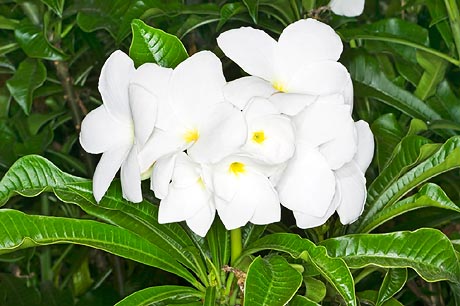Family : Apocynaceae

Text © Pietro Puccio

English translation by Mario Beltramini

6-8 months of blooming and dazzling whiteness of its petals © Giuseppe Mazza
The genus is honoured to the French missionary Charles Plumier (1646-1704), who collected and studied a great quantity of plants of the Caribbean area by the end of 1600; the name of the species is the Latin word “pudica” = pure, chaste, with reference to the candid white colour of its flowers.
Common names: “white frangipani”, “bridal bouquet”, “fiddle leaf plumeria” (English); “frangipanier blanc” (French); “alhelí”, “amapola blanca”, “amancaya”, “mapuche” (Spanish).
Evergreen or semi-deciduous plant, it appears as a shrub or as a tree of small or average size, with compact foliage which slightly expands with the shape of a cone, which can reach about the 5 metres of height; it has rather thin stems, grey in the older part, dark green in the younger one, and leaves with the typical “arrow” shape (oblong-spatulate) up to about 30 cm of length, of a glossy dark green colour. Terminal inflorescences with showy flowers, bisexual, funnel-shaped, with a diameter of 7-8 cm, with petals of a candid white colour with yellow fauces, inodorous. The fruits are fusiform, coupled, follicles, 15-25 cm long, containing several flat seeds provided with a membranous wing, which favour their dispersion. It usually and easily reproduces by cutting and by air layering.
Plant of great ornamental value, thanks to its copious blooming with a dazzling flowerage, which lasts, in the tropics, for 6-8 months per year and its typical foliage. Rather sensible to low temperatures plant, if outside from the tropical and subtropical zones, it must be cultivated in pot, in order to be sheltered in winter in a luminous space which temperatures which are not to get lower than 12-14°C, and to be replaced in open location in spring, possibly exposed towards the south, as it needs at least 6-8 hours of sun per day in order to give a good blooming.
Synonyms: Plumeria caracasana J.R.Johnst. (1908); Plumeria cochleata S.F.Blake (1918).
→ To appreciate the biodiversity within the APOCYNACEAE family please click here.
